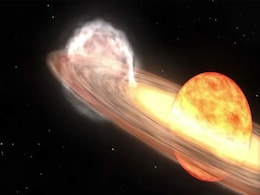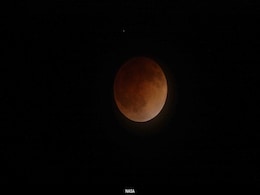Astronomer
- All
- News
- Videos
- Web Stories
-

First Future Type 1a Supernova Detected: White Dwarf Pair to Collide in 23 Billion Years
- Tuesday April 8, 2025
- Written by Gadgets 360 Staff
Astronomers have discovered a pair of white dwarf stars located about 150 light-years from Earth that are on course to collide and produce a Type 1a supernova in approximately 23 billion years. This is the first such system identified near our region of the galaxy. With a combined mass of 1.56 solar masses, the stars are slowly spiralling toward ea...
-
 www.gadgets360.com
www.gadgets360.com
-

JWST Captures Unseen Details of Exoplanets in HR 8799 and 51 Eridani Systems
- Thursday April 3, 2025
- Written by Gadgets 360 Staff
The James Webb Space Telescope (JWST) has captured groundbreaking images of exoplanets in the HR 8799 and 51 Eridani systems. By modifying its coronagraphs, astronomers allowed more starlight to pass through, revealing clearer planetary details. The study, published in The Astrophysical Journal Letters, highlights the first successful detection of ...
-
 www.gadgets360.com
www.gadgets360.com
-

T Corona Borealis May Erupt Soon: Rare Nova Could Be Visible to Naked Eye
- Tuesday April 1, 2025
- Written by Gadgets 360 Staff
T Corona Borealis, a binary star system in the Northern Crown constellation, is showing signs of an imminent nova eruption. The white dwarf star, which pulls material from its red giant companion, last erupted in 1946. Astronomers have detected patterns similar to previous eruptions, leading to predictions of a possible outburst within the next two...
-
 www.gadgets360.com
www.gadgets360.com
-

Two New Exoplanets Found Orbiting a Star in Draco Constellation
- Wednesday April 2, 2025
- Written by Gadgets 360 Staff
Astronomers have identified two exoplanets, TOI-1453 b and TOI-1453 c, orbiting a star 250 light-years away in Draco. The planets, a super-Earth and a sub-Neptune, were detected using NASA’s TESS satellite and the HARPS-N spectrograph. TOI-1453 b is a rocky planet orbiting close to its star, while TOI-1453 c is twice Earth’s size and may have a...
-
 www.gadgets360.com
www.gadgets360.com
-

James Webb Space Telescope Reveals a Stunning Einstein Ring in Hydrus
- Wednesday April 2, 2025
- NDTV
A striking new image from the James Webb Space Telescope reveals an Einstein ring in the Hydrus constellation. The phenomenon occurs when a massive foreground galaxy bends light from a hidden background galaxy, forming a near-perfect ring. This effect, predicted by Einstein’s theory of general relativity, helps astronomers study galaxies from the...
-
 www.gadgets360.com
www.gadgets360.com
-

Partial Solar Eclipse of March 2025: Satellite Images to Show Moon’s Shadow
- Saturday March 29, 2025
- Written by Gadgets 360 Staff
A partial solar eclipse will take place on March 29, 2025, visible across parts of Europe, Africa, and North America. The event will reach its peak in Nunavik, Canada, where 94% of the sun will be covered at sunrise. From space, weather satellites like GOES-16 and Himawari will capture images of the moon’s shadow. The International Space Station ...
-
 www.gadgets360.com
www.gadgets360.com
-

Astronomers "Astonished" After Oxygen Detected In Most Distant Galaxy
- Thursday March 20, 2025
- World News | Agence France-Presse
Oxygen has been detected in the most distant galaxy ever discovered, surprised astronomers said Thursday, offering further evidence that stars in the early universe matured far quicker than had been thought possible.
-
 www.ndtv.com
www.ndtv.com
-

Rakesh Roshan Confirms Not Directing Hrithik Roshan's Krrish 4: "I Have To Pass On The Baton"
- Tuesday March 18, 2025
- Entertainment | Written by NDTV Movies News Desk
Latest reports suggest that Krrish 4 has been further delayed because of its astronomical budget
-
 www.ndtv.com/entertainment
www.ndtv.com/entertainment
-

Hubble Telescope Captures NGC 4536, a Starburst Galaxy with Intense Star Formation
- Wednesday March 26, 2025
- Written by Gadgets 360 Staff
NASA’s Hubble Space Telescope has captured a striking image of NGC 4536, a starburst galaxy 50 million light-years away in the Virgo constellation. The galaxy’s sweeping spiral arms are filled with young blue star clusters and ionized hydrogen gas, indicating rapid star formation. Astronomers believe its bar-like structure channels gas toward t...
-
 www.gadgets360.com
www.gadgets360.com
-

James Webb Space Telescope Captures Hourglass Nebula LBN 483 in Stunning Detail
- Tuesday March 18, 2025
- Written by Gadgets 360 Staff
The James Webb Space Telescope has captured unprecedented details of LBN 483, a nebula located 650 light-years away. The striking hourglass-shaped structure results from outflows driven by a forming binary star system. JWST’s infrared imaging and ALMA’s radio observations reveal how stellar winds, jets, and magnetic fields sculpt the nebula ove...
-
 www.gadgets360.com
www.gadgets360.com
-

Don't Miss Tonight's 'Blood Moon': How To Watch, Stream, And Capture Lunar Eclipse
- Friday March 14, 2025
- Science | Edited by Nikhil Pandey
A highly anticipated total lunar eclipse, or "blood moon," will occur overnight on Thursday-Friday, visible in the Americas, Pacific and Atlantic oceans, and parts of Europe and Africa, offering a rare opportunity for sky-watchers, astronomers, and p
-
 www.ndtv.com
www.ndtv.com
-

Smallest Galaxy Ever Found: Andromeda XXXV Defies Cosmic Evolution Models
- Thursday March 13, 2025
- Written by Gadgets 360 Staff
Astronomers have discovered Andromeda XXXV, the smallest and faintest known galaxy, located 3 million light-years away. It challenges existing models of galaxy formation, as similar small galaxies were thought to be destroyed in the early universe. Researchers are studying how it retained conditions for star formation despite harsh cosmic environme...
-
 www.gadgets360.com
www.gadgets360.com
-

Holi Under The Blood Moon: Total Lunar Eclipse To Occur On March 14, 2025
- Thursday March 13, 2025
- Offbeat | Edited by Nikhil Pandey
A rare total lunar eclipse, also known as the Blood Moon, will coincide with Holi celebrations in India on March 14, 2025, captivating skywatchers with its unique reddish-orange coloration during totality, which will last for about an hour.
-
 www.ndtv.com
www.ndtv.com
-

4 Planets Found Orbiting Earth's Nearest Star. They Are Too Hot For Life
- Wednesday March 12, 2025
- World News | Asian News International
Astronomers have revealed new evidence that there are not just one but four tiny planets circling around Barnard's Star, the second-nearest star system to Earth.
-
 www.ndtv.com
www.ndtv.com
-

Hubble Captures Stunning Infrared Image of Sh2-284, a Massive Stellar Nursery
- Wednesday March 12, 2025
- Written by Gadgets 360 Staff
Hubble’s latest image of the massive Sh2-284 nebula reveals young stars concealed within thick clouds of gas and dust. Using infrared imaging, astronomers have captured details previously obscured in optical wavelengths. The nebula’s low-metallicity composition provides a glimpse into the conditions of the early universe, shedding light on how ...
-
 www.gadgets360.com
www.gadgets360.com
-

First Future Type 1a Supernova Detected: White Dwarf Pair to Collide in 23 Billion Years
- Tuesday April 8, 2025
- Written by Gadgets 360 Staff
Astronomers have discovered a pair of white dwarf stars located about 150 light-years from Earth that are on course to collide and produce a Type 1a supernova in approximately 23 billion years. This is the first such system identified near our region of the galaxy. With a combined mass of 1.56 solar masses, the stars are slowly spiralling toward ea...
-
 www.gadgets360.com
www.gadgets360.com
-

JWST Captures Unseen Details of Exoplanets in HR 8799 and 51 Eridani Systems
- Thursday April 3, 2025
- Written by Gadgets 360 Staff
The James Webb Space Telescope (JWST) has captured groundbreaking images of exoplanets in the HR 8799 and 51 Eridani systems. By modifying its coronagraphs, astronomers allowed more starlight to pass through, revealing clearer planetary details. The study, published in The Astrophysical Journal Letters, highlights the first successful detection of ...
-
 www.gadgets360.com
www.gadgets360.com
-

T Corona Borealis May Erupt Soon: Rare Nova Could Be Visible to Naked Eye
- Tuesday April 1, 2025
- Written by Gadgets 360 Staff
T Corona Borealis, a binary star system in the Northern Crown constellation, is showing signs of an imminent nova eruption. The white dwarf star, which pulls material from its red giant companion, last erupted in 1946. Astronomers have detected patterns similar to previous eruptions, leading to predictions of a possible outburst within the next two...
-
 www.gadgets360.com
www.gadgets360.com
-

Two New Exoplanets Found Orbiting a Star in Draco Constellation
- Wednesday April 2, 2025
- Written by Gadgets 360 Staff
Astronomers have identified two exoplanets, TOI-1453 b and TOI-1453 c, orbiting a star 250 light-years away in Draco. The planets, a super-Earth and a sub-Neptune, were detected using NASA’s TESS satellite and the HARPS-N spectrograph. TOI-1453 b is a rocky planet orbiting close to its star, while TOI-1453 c is twice Earth’s size and may have a...
-
 www.gadgets360.com
www.gadgets360.com
-

James Webb Space Telescope Reveals a Stunning Einstein Ring in Hydrus
- Wednesday April 2, 2025
- NDTV
A striking new image from the James Webb Space Telescope reveals an Einstein ring in the Hydrus constellation. The phenomenon occurs when a massive foreground galaxy bends light from a hidden background galaxy, forming a near-perfect ring. This effect, predicted by Einstein’s theory of general relativity, helps astronomers study galaxies from the...
-
 www.gadgets360.com
www.gadgets360.com
-

Partial Solar Eclipse of March 2025: Satellite Images to Show Moon’s Shadow
- Saturday March 29, 2025
- Written by Gadgets 360 Staff
A partial solar eclipse will take place on March 29, 2025, visible across parts of Europe, Africa, and North America. The event will reach its peak in Nunavik, Canada, where 94% of the sun will be covered at sunrise. From space, weather satellites like GOES-16 and Himawari will capture images of the moon’s shadow. The International Space Station ...
-
 www.gadgets360.com
www.gadgets360.com
-

Astronomers "Astonished" After Oxygen Detected In Most Distant Galaxy
- Thursday March 20, 2025
- World News | Agence France-Presse
Oxygen has been detected in the most distant galaxy ever discovered, surprised astronomers said Thursday, offering further evidence that stars in the early universe matured far quicker than had been thought possible.
-
 www.ndtv.com
www.ndtv.com
-

Rakesh Roshan Confirms Not Directing Hrithik Roshan's Krrish 4: "I Have To Pass On The Baton"
- Tuesday March 18, 2025
- Entertainment | Written by NDTV Movies News Desk
Latest reports suggest that Krrish 4 has been further delayed because of its astronomical budget
-
 www.ndtv.com/entertainment
www.ndtv.com/entertainment
-

Hubble Telescope Captures NGC 4536, a Starburst Galaxy with Intense Star Formation
- Wednesday March 26, 2025
- Written by Gadgets 360 Staff
NASA’s Hubble Space Telescope has captured a striking image of NGC 4536, a starburst galaxy 50 million light-years away in the Virgo constellation. The galaxy’s sweeping spiral arms are filled with young blue star clusters and ionized hydrogen gas, indicating rapid star formation. Astronomers believe its bar-like structure channels gas toward t...
-
 www.gadgets360.com
www.gadgets360.com
-

James Webb Space Telescope Captures Hourglass Nebula LBN 483 in Stunning Detail
- Tuesday March 18, 2025
- Written by Gadgets 360 Staff
The James Webb Space Telescope has captured unprecedented details of LBN 483, a nebula located 650 light-years away. The striking hourglass-shaped structure results from outflows driven by a forming binary star system. JWST’s infrared imaging and ALMA’s radio observations reveal how stellar winds, jets, and magnetic fields sculpt the nebula ove...
-
 www.gadgets360.com
www.gadgets360.com
-

Don't Miss Tonight's 'Blood Moon': How To Watch, Stream, And Capture Lunar Eclipse
- Friday March 14, 2025
- Science | Edited by Nikhil Pandey
A highly anticipated total lunar eclipse, or "blood moon," will occur overnight on Thursday-Friday, visible in the Americas, Pacific and Atlantic oceans, and parts of Europe and Africa, offering a rare opportunity for sky-watchers, astronomers, and p
-
 www.ndtv.com
www.ndtv.com
-

Smallest Galaxy Ever Found: Andromeda XXXV Defies Cosmic Evolution Models
- Thursday March 13, 2025
- Written by Gadgets 360 Staff
Astronomers have discovered Andromeda XXXV, the smallest and faintest known galaxy, located 3 million light-years away. It challenges existing models of galaxy formation, as similar small galaxies were thought to be destroyed in the early universe. Researchers are studying how it retained conditions for star formation despite harsh cosmic environme...
-
 www.gadgets360.com
www.gadgets360.com
-

Holi Under The Blood Moon: Total Lunar Eclipse To Occur On March 14, 2025
- Thursday March 13, 2025
- Offbeat | Edited by Nikhil Pandey
A rare total lunar eclipse, also known as the Blood Moon, will coincide with Holi celebrations in India on March 14, 2025, captivating skywatchers with its unique reddish-orange coloration during totality, which will last for about an hour.
-
 www.ndtv.com
www.ndtv.com
-

4 Planets Found Orbiting Earth's Nearest Star. They Are Too Hot For Life
- Wednesday March 12, 2025
- World News | Asian News International
Astronomers have revealed new evidence that there are not just one but four tiny planets circling around Barnard's Star, the second-nearest star system to Earth.
-
 www.ndtv.com
www.ndtv.com
-

Hubble Captures Stunning Infrared Image of Sh2-284, a Massive Stellar Nursery
- Wednesday March 12, 2025
- Written by Gadgets 360 Staff
Hubble’s latest image of the massive Sh2-284 nebula reveals young stars concealed within thick clouds of gas and dust. Using infrared imaging, astronomers have captured details previously obscured in optical wavelengths. The nebula’s low-metallicity composition provides a glimpse into the conditions of the early universe, shedding light on how ...
-
 www.gadgets360.com
www.gadgets360.com























